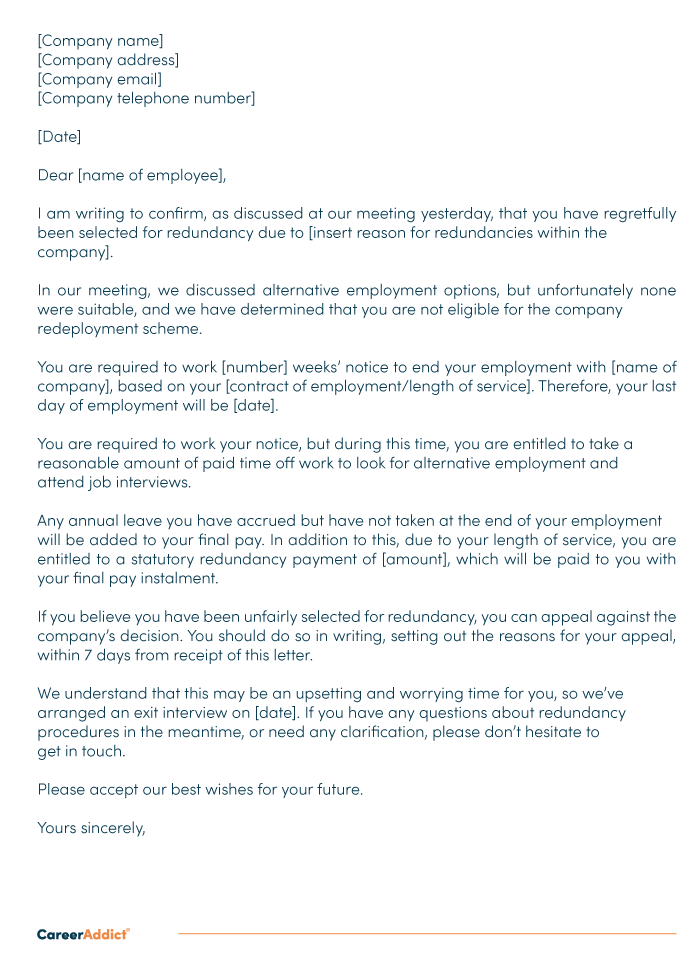Small Business Closing Employee Rights UK: What You Required to Find Out About Redundancy
Small Business Closing Employee Rights UK: What You Required to Find Out About Redundancy
Blog Article
Discovering the Operational Dynamics of Firm Redundancy and Its Long-Term Sustainability

Redundancy Methods for Business Continuity
In order to guarantee undisturbed operations, companies need to execute effective redundancy approaches for company continuity. Redundancy in this context refers to the duplication of critical parts or functions within a system to mitigate the influence of prospective failures. By including redundancy techniques, companies can improve their strength versus interruptions triggered by numerous factors such as all-natural catastrophes, equipment failings, or cyber-attacks.
One usual redundancy method is the application of back-up systems and data storage options. This entails developing matches of necessary data and systems that can be turned on in instance of a primary system failing. Furthermore, organizations can develop repetitive communication networks and source of power to maintain connectivity and operations throughout unforeseen occasions.
Moreover, cross-training workers to do multiple roles within the business can act as a useful redundancy strategy. If crucial workers are not available due to disease or various other reasons, this ensures that vital tasks can still be brought out also. Overall, effective redundancy approaches are crucial for businesses to maintain operational continuity and reduce the effect of prospective disruptions.
Effect of Redundancy on Organizational Strength
Provided the crucial function redundancy strategies play in guaranteeing organization connection, exploring the impact of redundancy on business strength comes to be imperative for recognizing the alternative operational characteristics of a company. Organizational durability refers to an entity's capacity to adjust to interruptions, recover from setbacks, and change when essential while preserving core features. Redundancy, when strategically applied, can significantly add to improving a company's resilience when faced with unexpected obstacles. By having backup systems, workers, or procedures in area, firms can much better withstand shocks and proceed operations with minimal disturbance.
In addition, redundancy can promote innovation and imagination within a company as employees feel empowered to take computed threats, recognizing that there is a safety and security web to sustain them in instance of failing. In general, the effect of redundancy on organizational resilience is extensive, shaping check my site the lasting sustainability and success of a business.
Balancing Performance and Adaptability in Redundancy
Attaining an unified balance in between operational performance and adaptive flexibility is an essential obstacle in the tactical release of redundancy within companies. As well much versatility without a solid functional structure can result in inefficiencies and disparity.
To balance performance and versatility in redundancy preparation, organizations need to very carefully examine their operational requirements, market dynamics, and tactical objectives. Carrying out lean methods can boost effectiveness by simplifying processes and getting rid of waste, while fostering a culture of versatility and constant enhancement can improve flexibility. Additionally, buying cross-training programs and robust interaction networks can help grow a flexible labor force qualified of handling varied jobs throughout durations of shift. Ultimately, finding the ideal stability in between performance and adaptability is vital for constructing a sustainable and durable organization in the face of unpredictability.
Long-Term Sustainability With Redundancy Planning
To make sure long-lasting practicality and stability, organizations should strategically straighten their redundancy preparation with long-lasting sustainability goals, thus integrating functional performance with adaptive adaptability. Long-lasting sustainability through redundancy preparation includes content greater than simply temporary cost-cutting procedures. It calls for an extensive strategic strategy that expects future obstacles and opportunities. Companies need to see redundancy not as a responsive service to immediate troubles however as a positive strategy for long-lasting success. By integrating redundancy preparation with sustainability goals, companies can create a resistant framework that can endure numerous market fluctuations and interior adjustments.

Proactive Actions for Sustainable Business Procedures
Exactly how can business proactively enhance their functional sustainability for long-lasting success? Carrying out proactive procedures is crucial for business intending to make sure sustainable operations. One key method is to buy technology and development to streamline procedures, lower waste, and stay affordable in the marketplace. Adopting sustainable methods such as minimizing power intake, reducing carbon footprint, and maximizing resource application can not just profit the setting but likewise cause cost savings in the future.
Moreover, cultivating a society of continual renovation and knowing within the organization can boost flexibility to changing market problems and customer needs. Urging staff member participation in decision-making processes and supplying opportunities for professional growth can improve spirits, performance, and total efficiency. Establishing clear goals, keeping track of key efficiency indicators, and frequently assessing progress are essential parts of aggressive sustainability monitoring.
Working together with suppliers, consumers, and various other stakeholders to advertise sustainable methods throughout the supply chain can develop a surge site link result of positive effect - redundancy pay if company goes bust. By taking positive steps towards operational sustainability, firms can build strength, drive advancement, and secure their long-term success in an ever-evolving organization landscape
Conclusion

In the realm of organizational management, the critical implementation of business redundancy stands as an essential yet elaborate practice that demands a delicate balance in between operational performance and long-lasting viability. By exploring the operational characteristics that underpin business redundancy and reviewing its wider implications for organizational strength and versatility, a nuanced understanding of just how redundancy techniques can form the future trajectory of a business starts to unravel.Provided the vital duty redundancy techniques play in ensuring service continuity, discovering the impact of redundancy on business strength becomes crucial for understanding the all natural operational characteristics of a firm. On the whole, the influence of redundancy on business resilience is extensive, shaping the long-lasting sustainability and success of a company.
In final thought, understanding the operational characteristics of firm redundancy is essential for making sure long-term sustainability.
Report this page